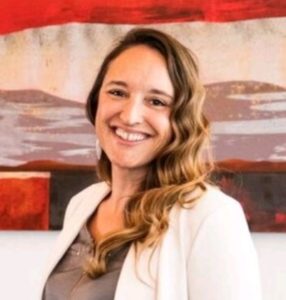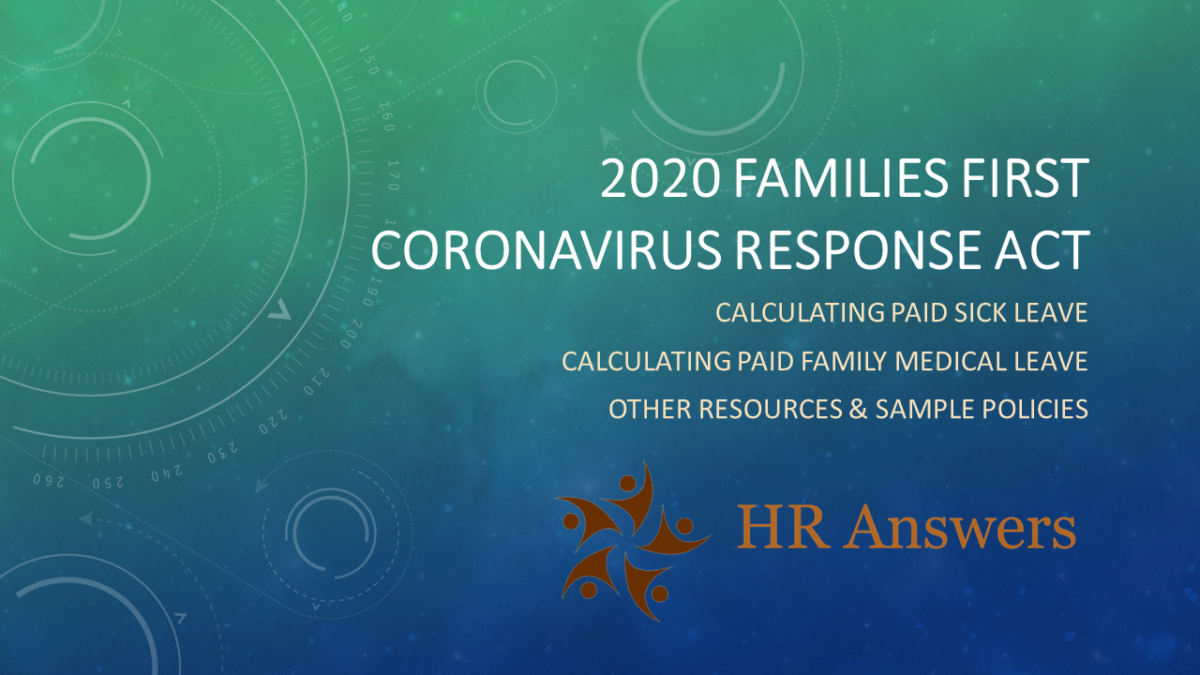Updated, 04/15/2020
Friends,
Niki Ramirez, your HR consultant here. I cannot stop thinking about you.
Your employees are on my mind, and I’m keeping you in my thoughts and sending well-wishes during these uncertain and unusual times.
We have been extremely busy working to research, analyze and understand the new employer obligations under the FFCRA – Paid Sick Leave and Public Health Emergency Leave.
Signed into law, and effective April 2, 2020, the FFCRA amends the Family and Medical Leave Act (“FMLA”) which you may have heard of before. In the past, the FMLA applied to employers with 50+ employees. The passage of the FFCRA expands coverage for employees; mandating that employers with 1-499 employees comply with the new rules.
Here is a quick and basic overview of what is happening – and what is required as of April 15, 2020:
H.B. 6201 was passed by the House, Senate and signed into law by the President in the last week. This is a new law providing job-protected leave and paid sick leave for all American employees will go into effect in 15 days (April 2, 2020).
What we know:
Employers with over 500 employees are exempted from this expanded coverage/rule.
For employers with 1 to 499 employees, the are 6 [public health emergency-related] qualifying reasons for coverage under this law. The National Law Review describes them as follows:
- The employee is subject to a federal, state, or local quarantine or isolation order related to Covid-19;
- the employee has been advised by a health care provider to self-quarantine due to concerns related to Covid-19;
- the employee is experiencing symptoms of Covid-19 and seeking medical diagnosis;
- the employee is caring for an individual who is subject to a federal, state, or local quarantine order, or the individual has been advised to self-quarantine due to concerns related to Covid-19;
- the employee is caring for the employee’s son or daughter, if the child’s school or child care facility has been closed or the child’s care provider is unavailable due to Covid-19 precautions; or
- the employee is experiencing any other substantially similar condition specified by Health and Human Services in consultation with the Department of the Treasury and the Department of Labor.
Benefits for Employees:
- “Normal” FMLA is unpaid, but under the FFCRA, employees who are on COVID-related sick leave because they can receive their full pay, up to $511 per day, or $5,110 total.
- Leave taken to care for children whose schools or day care facilities have closed because of the COVID-19 pandemic, can receive pay at two-thirds their regular rate of pay, with a maximum of $200 per day or $10,000 total.
- Employers cannot force employees to use up vacation or other sick time before receiving this new Paid Sick Leave benefit.
- There is a 10-day waiting period before the Paid Family Leave benefit applies. Employees can use existing sick or vacation time to cover these days.
CALCULATING PAY
Under the Emergency Paid Sick Leave (EPSL) Provisions:
- No wait period applies.
- Full-time employees are eligible for 80 hours of Paid Sick Leave
- The employee’s average hours over a two-week period for part-time employees
- The per-day average hours over the 6-month period before the leave starts for a period of two weeks for employees without a regular schedule
- The employee’s reasonable hours expectation for a two-week period for employees without a regular schedule who did not work over the six-months prior to the leave starting.
Under the Expanded Family Medical Leave (EFMLA) Provisions:
- The first 10 days of COVID-related FMLA leave are unpaid. However, an employee may choose to use any accrued
vacation, personal leave, or medical or sick leave during this unpaid period of leave. - After that initial period 10-day, employers must pay employees who use public health emergency FMLA.
How to calculate Expanded Paid Family and Medical Leave Leave:
- After the initial 10 days of unpaid leave, the employer must pay 2/3 of the employee’s regular rate of pay for the hours the employee would normally be scheduled to work; capped at $200 per day and $10,000 total.
- VARIABLE Schedule Employees: If an employee’s schedule varies so much that the number of hours an employee would have worked cannot be determined with certainty, the number of hours and employee would normally be scheduled to work is replaced by the average per-day hours the employee was scheduled to work over the preceding 6 months. Scheduled work time should be calculated to include time the employee used paid leave.
- For an employee with a variable schedule who has not been employed for 6 months, the employee’s reasonable expectation at the time of hiring for the number of hours worked per day is used.
Can you request documentation to substantiate the need for EPSL or EFMLA?
Employers are allowed to ask for documentation from their employees, but are cautioned against taking action against an employee who doesn’t provide it but attests to the fact that they needed leave for a qualifying reason.
Our team can help you prepare a custom form for your company that will outline requirements and seek all permitted information. Contact us if we can help.
Need help calculating pay? Check out the tool being offered by my payroll provider:
- Most payroll providers are offering an option to assist their clients with pay tracking.
- My payroll company is Proliant. They not only help with tracking what is paid so that clients can claim their tax credits in a timely fashion… They also help calculate your employees’ pay based on their previous hours and earnings. I have yet to see another company offering that comprehensive of a tool!
- Take a peek at their Health Assessment questions list and sign up for a DEMO here!
- If you make the transition to their system now, they will upload the last two years’ payroll data so that you won’t miss a beat!
- … p.s. … I don’t receive a financial incentive for sharing this information – just thought you should know about it!
Financial Relief for Employers:
- Employers receive tax credits for 100 % of what they pay out to employees, up to the above-noted limits.
- For employers with 50 or fewer employees, the Secretary of Labor can exempt the business from these requirements. It is entirely unclear how a business would receive an exemption. Your trusted legal professional may be able to advise. We will be seeking additional information on this.
- Employers with fewer than 25 employees do not have to restore employees to their previous positions if the business has changed substantially from the onset of their covered leave.
- Additional information, including examples, on the IRS website when you click here.
No Retaliation
As is to be expected, there is language that instructs that employers cannot retaliate in any way against an employee who wishes to take leave or requests paid sick time under the new/expanded rules.
The U.S. Department of Labor issued FAQ’s on March 24, 2020, which have been continually updated since then – DOL FAQs can be found here.
An UPDATED sample policy is ready. CLICK HERE to access your copy.
Each organization is affected differently. Let us help customize your plan and your policy.
Schedule a private call with a trusted HR Advisor.
We recommend scheduling a Quick Fire Coaching call – a virtual session to discuss your HR and workplace questions and concerns.
These Quick Fire Coaching sessions are affordably priced at a reduced rate so that business leaders can get the guidance and support they need, and carry on with business.
 Meet Your Consultant.
Meet Your Consultant.
Niki Ramirez is a certified human resource professional with over 20 years of successful experience in leadership and human resources management and is a sought-after and trusted industry expert.
She has created a unique and practical approach to HR, carefully balancing employees’ and employer’s needs. Niki believes in the power of collaboration and communication and that success is accomplished is through the dedication of great employees who feel respected and empowered in the workplace; success is accomplished through the dedication of great employees who feel respected and empowered in the workplace.
She takes a practical approach to human resources and focuses on guiding teams to work in partnership to design and implement meaningful workplace policies, practices and programs rooted in collaboration, respect, trust and open communication creating a positive ripple in the world.
Niki has served in a variety of operational management and leadership roles, including as the Director of Human Resources for the Wild Horse Pass Development Authority and for the Kyrene School District, where she led human resources for department of over 300 employees at 16 locations. Niki is proud to provide HR consultation, as well as training and development support for Native American governments and their enterprises as well. She been an invited speaker at the National Native American HR Association Annual Conference for 6 years and counting. In addition, Niki has served as a human resources consultant with a Fortune 500 company, as well as community adjunct faculty at Chandler Gilbert Community College.
In addition to her three HR professional certifications, one being a specialized certification in the practice of HR within Native American Tribal enterprises and governments, Niki is bi-lingual in Spanish/English, holds a Bachelor of Arts degree in Spanish from Arizona State University, and an MBA in HR Management from the University of Phoenix.




